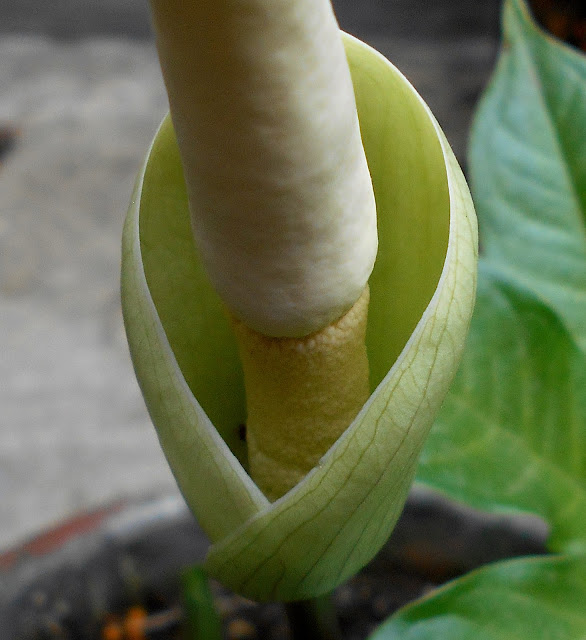An eleven-year itch
The original plant was given to me by Andreas Wistuba in mid-2010, and has since proven to be a very forgiving species, withstanding neglect, bad soil, even worse weather, and terrible water quality. However, as vigorous and adaptable the plant is- it has since given rise to countless offsets which have been released to a handful of collectors from the Philippines- it failed in the flowering department, until now. That is a record-breaking, hair-pulling eleven years of waiting. I probably would have flowered an A. titanum from seed much sooner.
These are rather small plants seldom attaining heights in excess of a foot, with gray-brownish petioles finely striped longitudinally with dark brown. The leaflets are minimally divided, and one thing I have noticed, which was not mentioned in the original description, is that the leaflet surfaces have a somewhat iridescent surface, turning bluish-green at a certain angle from the light. After each growing season, the smooth corms give rise to offsets which usually detach fully after the next dormancy. The plants require bright, filtered light and are not finicky about soil composition or chemistry for as long as it is free-draining. I leave the dormant corms in the soil and watered once to twice a week, as I have found that in my tropical and seasonal conditions, the corms become mealybug magnet when stored out of the soil.
 |
| That is obviously not a leaf. Photo taken during an overcast August 3 afternoon. |
The entire structure is 23 cm tall with incurved spathe margins- this trait is a spot character that allows it to be instantly distinguishable from related species, such as A. brevispathus and A. interruptus. The scent is very weakly fetid, in contrast to the assault of the similar A. brevispathus; the odor of A. prolificus also lacks the gas-like smell of the latter. By noon, the odor is non-evident. Tiny brown beetles, which I have previously observed in A. merrillii (see the post here), are attracted to the weak carrion scent and linger until the evenings, even when there is no discernible odor. In fact, the carrion aroma is released only in the first few hours upon the opening of the spathe and that's it.
 |
| Understated elegance of the green spathe finely striped with brown-green. |
Amorphophallus prolificus was described by Wilbert Hetterscheid and the late Alan Galloway in 2006, based from a specimen cultivated at the Botanical Garden at Wageningen University, and collected somewhere in central Thailand. Since Andreas personally knows Wilbert, it may be assumed that my plant also originated from one of the specimens that are currently housed at the Wageningen collection. It seems that this species is very infrequently seen in cultivation, even among collectors with a taste for the odd and hard to find. A search for this species in the Facebook group Amorphophallus yields only a handful of posts, none of which shows a plant in bloom (I also happen to have a post there showing the leaf and the petiole, from Aug. 20, 2011). Internet photos are also wanting, with the available photos coming mostly from Alan's website. Considering its ease of cultivation and propagation, one would expect this to be a mainstay, but such isn't the case. Its small size and lush growth, and near reluctance to aggravate the olfactory senses would be perfect for those with limited spaces and/or is searching for something that would not convince the neighbors to call the police and have your place searched.
 |
| Note the tiny beetles congregating immediately beneath the appendix, above the male zone. |
For this species' protologue, please proceed here.





Comments
Post a Comment